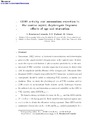Identificador persistente para citar o vincular este elemento:
https://accedacris.ulpgc.es/jspui/handle/10553/7222
| Título: | GDH activity and ammonium excretion in the marine mysid, "Leptomysis lingvura": effects of age and starvation | Autores/as: | Fernández-Urruzola, Igor Packard, Theodore T Gómez, May |
Clasificación UNESCO: | 251001 Oceanografía biológica | Palabras clave: | Glutamate dehydrogenase Ammonium excretion Leptomysis lingvura Starvation Body size |
Fecha de publicación: | 2011 | Publicación seriada: | Journal of Experimental Marine Biology and Ecology | Resumen: | Ammonium (NH4+) release by bacterial remineralization and heterotrophic grazers determines the regenerated fraction of phytoplankton productivity, so the measurement of NH4+ excretion in marine organisms is necessary to characterize both the magnitude and the efficiency of the nitrogen cycle. Glutamate dehydrogenase (GDH) is largely responsible for NH4+ formation in crustaceans and consequently should be useful in estimating NH4+ excretion by marine zooplankton.<br />Here, we address body size and starvation as sources of variability on the GDH to NH4+ excretion ratio (GDH/RNH4+). We found a strong correlation between the RNH4+ and the GDH activity (r2 = 0.87, n = 41) during growth. Since GDH activity maintained a linear relation (b = 0.93) and RNH4+ scaled exponentially (b =0.55) in well fed mysids, the GDH/RNH4+ ratio increased with size. However, the magnitude of its variation increased even more when adult mysids were starved. In this case, the GDH/RNH4+ ratio ranged from 11.23 to 102.41. | URI: | https://accedacris.ulpgc.es/handle/10553/7222 | ISSN: | 0022-0981 | DOI: | 10.1016/j.jembe.2011.07.035 | Fuente: | Journal of Experimental Marine Biology and Ecology [ISSN 0022-0981], v. 409 (1-2), p. 21-29 |
| Colección: | Artículos |
Citas SCOPUSTM
17
actualizado el 08-jun-2025
Citas de WEB OF SCIENCETM
Citations
12
actualizado el 08-jun-2025
Visitas
67
actualizado el 09-dic-2023
Descargas
177
actualizado el 09-dic-2023
Google ScholarTM
Verifica
Altmetric
Comparte
Exporta metadatos
Este elemento está sujeto a una licencia Licencia Creative Commons

